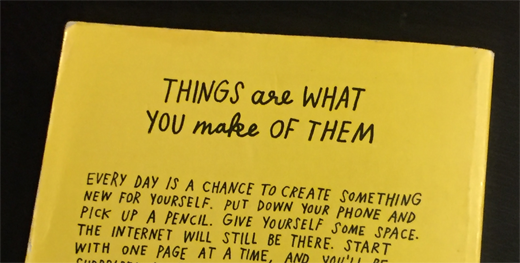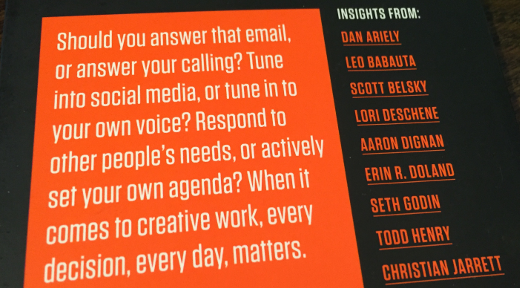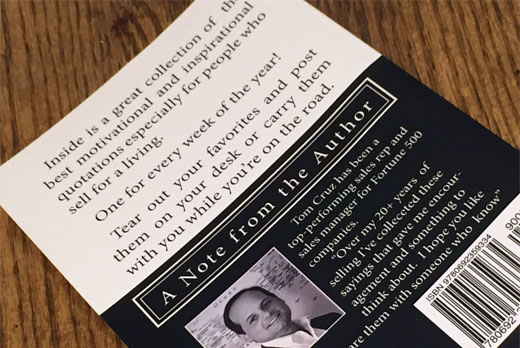My Takeaways So Far From The Book 1 Page At A Time
A consequence of being in a routine is that our entire body can be consumed by it. Where things like repetitive strain injuries or simply being sore from sitting on our butt for a long time are obvious, what isn’t as apparent is the impact on our brain.
If you don’t believe me, here’s an example – you are buzzing along in what you do all day and someone comes along and asks you a question, and all you can do is stare back dumbfounded. They may have well as used a Sharpie and wrote it on a pool noodle and hit you with it. Call it brain fatigue, but does it show a sign your brain needs some exercising?
When I saw the book 1 Page at a Time – A Daily Creative Companion by Adam J. Kurtz sitting on the shelf at Judy Maxwell Home in Chicago, I couldn’t help but pick it up. (If you don’t know about this store, think Spencer Gifts with an old-world flair and a sharper edge; it’s also owned by actress Joan Cusack, so that adds to its eccentricity) It only took me flipping through the first few pages and I was sold. It is an adult workbook, with a page a day dedicated to a brief creative exercise to do in the book.
Each page presents a unique activity, from making a list to drawing a picture to whatever. Some are quick and easy, some require actual thought. As it’s a page a day, and I started late last year, I am not done yet – thus the “so far” in the title – but I have enjoyed every exercise so far.
Though I have much to go, I feel my takeaways from 1 Page at a Time will endure and be reinforced as I go through it.
Think Different – Borrowing from the infamous Apple tag line, this book does just that. It asks you to do things you most likely don’t normally do on a regular basis as part of your job or even for fun.
Challenge Yourself – As some of the activities have required me to sit back and ponder before putting pen to page, it’s been extremely helpful to have a challenge that is outside of my normal work and life challenges, which tend to be more technical, business and child-focused.
Draw – When was the last time you drew a picture? For the fun of it? This is probably why adult coloring books are all the rage these days. Where many of you reading this may not consider yourself an artist, the drawing I am talking about is not about being an artist. Rather, it is about expressing something with visualization.
On occasion a day or 2 go by when I don’t do a page a day, but then I catch up on them. I tend to do them in page sequential order, but there is no reason you can’t flip around and choose one at random. I never read ahead, as I like to approach these with some spontaneity.
I highly recommend getting a copy of 1 Page at a Time, or get 2 – 1 for yourself and 1 for a friend. If you have it and are using it, I’d love to hear what you think about it in the comments to this post.
This is from The Hot Iron, a journal on business and technology by Mike Maddaloni.
Did you enjoy this? Subscribe to The Hot Iron by RSS/XML feed or Read by Email.
Book Take-Aways • Business • Strategize • Thrive • (3) Comments • Permalink
My Takeaways From The Book Manage Your Day-To-Day
So, how is your day going?
Whenever asked that question, or just now as you read it, you may have begun it with a sigh or groan, or some insincere sense of enthusiasm. As much as we can plan days and focus on whatever we need to do, there are plenty of factors working against us and disrupting our momentum. These disruptors will never go away, and our only choice is to try to bring elements in to manage or counter them.
When I heard about the book Manage Your Day-To-Day: Build Your Routine, Find Your Focus and Sharpen Your Creative Mind I said to myself, “self, how can I pass on reading this?” The book is a collection of writings and interviews with 20 “creative minds.” Where some I have heard of, like Seth Godin and Tony Schwartz, most of the rest I had not. Yet each of the contributors were very intriguing, yet practical. Manage Your Day-To-Day is a good read that gets you thinking about your own routines and practices and how to get the “most” from them, whatever “most” means to you.
As I read the book, my takeaways from it were not from the specifics of the book, rather from its big picture, and are as follows.
Misery loves company, but only if you want to be miserable together – As I read the dozen pieces from the 20 authors, nobody was saying that they have overcome chaos and their lives are exactly as they want them. Yet they did admit to challenges and offered both general and specific advice on how they are conquering what challenges them.
You deserve a break today – How many times have you been working on something and someone asks you about lunch, and you are thinking, “gee, I just had breakfast!” (Ok, you can put your hands down now.) I have written man times here at The Hot Iron about the creative process – or if you are so inclined, simply thinking – and the need to get away to change the scenery, recharge the brain and come back with a fresh focus.
In my current role, in the employee handbook for my firm it actually mentions taking breaks during the day just for that reason. As a matter of fact, I am writing this very blog post on one of those breaks. And on the way to the Starbucks where I am writing this, I was able to easily think through something for work that my brain kept tripping on. Where I thought I dropped the ball on something, I actually did not, and completely followed through. A nice thought to have in my head as I return to the office.
Where was Scrum? – As I read this book after reading Jeff Sutherland's book on Scrum, using Scrum would be a perfect way to help you manage the creativity. As a matter of fact, I recently setup my own scrum board for myself, with tasks such as writing this blog post and fixing the closet doors in my kid's bedroom.
I recommend Manage Your Day-To-Day for anyone who is looking for ideas and encouragement on improvement of their productivity or just to add some calm into their lives. This book is one I bought myself after reading about it somewhere – sorry, I forgot, as I have had the book for a while. As I always pass along books, for this one I placed it on a shelf in the kitchen of my office with other books people have left there as a mini-library. It will be interesting if anyone takes it, and even more so if they took it after reading this blog post!
Have you read Manage Your Day-To-Day? I welcome your thoughts on the book in the comments of this post.
This is from The Hot Iron, a journal on business and technology by Mike Maddaloni.
Did you enjoy this? Subscribe to The Hot Iron by RSS/XML feed or Read by Email.
Book Take-Aways • Business • Diversions • Strategize • Thrive • (0) Comments • Permalink
My Takeaways From The Book 52 Motivational Quotations For Salespeople By Tom Cruz
We all sell. Whether the word “sales” is in our job title or not, we all “sell” in some regards. From persuading a solution at work to convincing someone to date us to everything in between and all around, there is some element of selling in our lives.
Where we can succeed in selling, many times we do not. And when we do not, we can react to it in any number of ways. Whether we like it or not, we have to try to sell again. For some, getting back into the proverbial saddle is easy, and for others or just other times, we may need help. One way to get that help is from words of encouragement.
My good friend Tom Cruz has had the word “sales” on his business cards over his entire career (and when I say good friend, I stood up in his wedding and once flew live lobsters out to his house in LA from Boston, but I digress). When I heard he wrote a book titled 52 Motivational Quotations for Salespeople, I knew I had to read it. Of course it is always to support a friend, bit I knew it would be a great collection and motivator as well.
Friend bias aside, I enjoyed this short book. Each quote is on a separate page, allowing you to tear them out and hang them up. As with any book, I had a few takeaways from it:
We need to find what works for us – Reading through a book of motivational quotes in itself won’t necessarily make it a better day. Or maybe it will. We have to find what works for us, though trial and error, and it may be a third-party sharing something with you.
Explore beyond words – We often hear names of people and quotes that have been attributed to them. But who are these people? Were they business or religious leaders? Were they ax murderers or musicians? Does the quote define them or just confuse you? As I went thru this book I ended up searching several names I did not know.
Write your story – Where these quotes are just that, individual sets of words from others, combined they are part of my friend Tom Cruz’s life journey, and thus tell part of his story. We all have a story to tell or at least record for curious others – now or in the future – whether our child or a stranger. No matter who, our story may be of interest to someone someday.
Note Tom did not ask me to write this, nor did he give me a copy of it. I will make sure to give him a signed copy of my future book someday! As I pass along book I read to others, I am sending this one to a common friend of both of ours, who also works in sales, and should publish his own book too.
Were you intrigued or inspired to get 52 Motivational Quotations for Salespeople? Have you thought of publishing your own quotes? I welcome your thoughts in the comments to this post.
This is from The Hot Iron, a journal on business and technology by Mike Maddaloni.
Did you enjoy this? Subscribe to The Hot Iron by RSS/XML feed or Read by Email.
Book Take-Aways • Business • Thrive • (0) Comments • Permalink
My Takeaways From The Book Evolutionary Eating By Dr. Theresa Nesbitt
Over the summer I was seriously considering weight and diet counseling. As, well, let's just say I need to lose a few pounds, and with the increasing demand of little kids – plus the fact I am not getting any younger – it was more than time to take action.
When I talked with a colleague who is also a doctor about this, he asked me if, before I committed time and money to a program, I could commit US $15 on a book. As you cant even get a mediocre mixed drink in some Chicago bars for that, I said, “why not?” It was then that he recommended I read a book written by a friend of his, Dr. Theresa Nesbitt, titled Evolutionary Eating: How We Got Fat and 7 Simple Fixes.
As the book was recommended by someone I trust, I bought it. But I have to admit – by the title alone, which I thought was cliché for a health book, I probably wouldn't have otherwise bought it. But I did, and I am glad I did. And it has worked for me too, but I will save that for the end of this post.
So it is probably needless to say that I had several take-aways from this book, and here's some of the top ones I'd like to share:
We Never Really Learned Everything About Eating – Looking back on growing up, plus raising my own little angels, most of what we teach our kids about eating is more logistical – use utensils, don't put food in your hair, chew with your mouth closed – but we don't have as much focus on when to eat, what to eat and why.
Eat 3 Meals A Day At Routine Times – By eating consistently, or as consistently as possible, your body “knows” when to process food coming in and when to process stored fat, and by doing so you will use that excess stored energy and lose weight. I had an uncle who did this, eating 3 meals a day of the food he grew and raised and he lived to his mid 90's.
Keep It Real By Eating Real Food – Stick to basic and real foods and less or no processed or manufactured foods, or as Dr. Nesbitt calls “food forgeries” as our bodies are built for processing natural foods and not artificial or manufactured ingredients, flavors and additives. The original TV chef, Julia Child, always cooked with real butter, lard and wine and she lived to her 90's as well.
No Snacking – If you eat 3 meals a day only, you are thereby not snacking. Of course this goes beyond everything out there in society, at least modern American society. This for me has been personally tough, especially with earlier said angels who are ever growing and snacking. But by me snacking I too am ever growing, but in a bad way, and by not snacking, that has subsided.
How Vegetable Oil Is Made – Vegetable oil is supposed to be better than other oils, but they don't necessarily squeeze veggies to get the oil, unlike with olive oil. A chemical process is used to get it, and where the book introduces this I have done my own research as well. I'll stick with olive oil, or as I have been doing, I will forego oil altogether and use a variety of natural foods to add flavor.
Any Change Requires Willpower – This is probably the only thing I disagree with the author on. She states that by learning how to eat better, no willpower is involved. For someone like myself who has been eating the same way for almost half a century, willpower isn't only involved, it is direly needed! In the past I have lost weight, but always ate the same, and then it was more involved with a high level of exercise. When I stopped exercising, the weight came right back.
Some of these are of the 7 “simple fixes” that Dr. Nesbitt offers, and if you are intrigued as to what they all are, I recommend getting a copy of this book. As for the book as a whole, it is a very good and easy read – not intense, educational and supportive with a touch of humor, all the while not being too preachy. I recommend Evolutionary Eating not only for someone looking to lose weight, but for anyone looking to eat better or to support someone losing weight.
As for myself, I read the book over summer and it really resonated with me. I have changed my diet quite a bit, eating more salads without dressing, and cutting out most all breads. I still eat pizza and pasta, but I try to eat less of it. It has been far from perfect, and sometimes a struggle, but when I am hungry a coffee or seltzer will do the trick. Since simmer, I have lost about 25 pounds. I have a lot more to lose, but I am pleased with the results so far!
I have shared this book with my immediate family, and have given my copy to a friend. If you read Evolutionary Eating, I welcome your thoughts on it in the comments of this post.
This is from The Hot Iron, a journal on business and technology by Mike Maddaloni.
Did you enjoy this? Subscribe to The Hot Iron by RSS/XML feed or Read by Email
Book Take-Aways • Strategize • Thrive • (0) Comments • PermalinkMy Takeaways From The Book Scrum by Jeff Sutherland
Imagine a workplace where not only you can work without impediments to your progress, but one where you have a say in what and how you do it? And to top of it you’re much more productive and successful and so is your ultimate business customer.
So what’s the catch? You simply have to drop the current way you work and adopt something called Scrum.
What is Scrum? The origins of the word come from the sport rugby, where a tight formation of players move and work together to get the ball forward. The term Scrum here has its origins on software development, where a small team of people work closely together to build software. The difference is in how they build it – using an iterative cycle of a few usable features at a time rather than defining everything upfront, then months (or years) later receiving software with all of the features.
The later process I described above is commonly referred to as “waterfall.” As one giant cycle produces all software (or the falling water) and the remaining project time is used to fix bugs and make changes in the business process (or the water flowing from the waterfall). It is far from a perfect system, especially as it doesn’t take into consideration business changes, let alone end users not always knowing what they want, both upfront or a year from now!
The former process I described above is Scrum, and was created in the 1990’s by Jeff Sutherland and Ken Schwaber. This book, Scrum: The Art of Doing Twice the Work in Half the Time, is written by Sutherland, and presented in a format to introduce Scrum to the wider world outside of software.
As someone who has built software all of my professional career and then some and has used scrum formally in some of my past roles, I was interested to read this book, not only because it is written by one of the co-founders of Scrum, but to learn more how it can be used in other aspects of business and life.
Among my many thoughts from reading Scrum, I have the following takeaways:
- Building software – or anything really – is a journey – It’s hard to be perfect and know upfront everything you will possibly need in software you will use. Rather, admit it is a journey, build it over time, and get it closer to your needs while getting functioning features along the way.
- You have to be committed to Scrum to reap its true potential – Dipping your toes in the Scrum swimming pool will not give you the benefits of it. You have to fully commit to it. If you are hesitant to commit, read the book.
- If you don’t do it someone else will – Scrum as a framework is always gaining in popularity, and the number of people becoming certified in Scrum as well. If you or your organization is resistant to it, realize more organizations are always adopting it.
- I want to be Scrum Certified more now than before – after reading the book and hearing Sutherland’s stories of Scrum’s successes in business and beyond, I really want to take formal Scrum training and become certified more than I did before reading the book.
Scrum: The Art of Doing Twice the Work in Half the Time is a great read, for those who work in business or any organization. I wish I had this book years ago when I was starting my Web consulting business – not just for building the Web software but for the overall running of my business. It is packed with stories of its successful use in various industries. Though it is very supportive of Scrum, it is not a “fluffy” and rah-rah story – it gets straight to the point and reinforces all that is stated. The book concludes with a step-by-step plan for deploying Scrum.
This is the part of my book takeaways where I disclose why I read a book. As I said, when I heard of it, I needed to get it and bought it myself, and for 2 reasons. The first and most important is that I wanted to read the story. The second and anecdotal reason is that I once worked at the same company as Jeff Sutherland, and we once had a brief work-related phone call. As I read Scrum, I could hear his no-nonsense style, which added to the reading.
As I conclude this post, I have not decided whom to give the book to, as it is something I do after I read one. If you are interested let me know. If you have read the book, or based on this are interested to, I welcome your thoughts in the comments to this post.
This is from The Hot Iron, a journal on business and technology by Mike Maddaloni.
Did you enjoy this? Subscribe to The Hot Iron by RSS/XML feed or Read by Email
Book Take-Aways • Build • Business • Agile / Scrum • Strategize • Technology • Thrive • (2) Comments • Permalink






